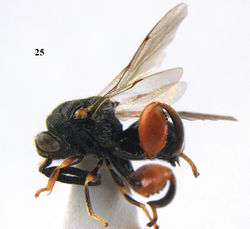Brachymeria alternipes
| Notice: | This page is derived from the original publication listed below, whose author(s) should always be credited. Further contributors may edit and improve the content of this page and, consequently, need to be credited as well (see page history). Any assessment of factual correctness requires a careful review of the original article as well as of subsequent contributions.
If you are uncertain whether your planned contribution is correct or not, we suggest that you use the associated discussion page instead of editing the page directly. This page should be cited as follows (rationale):
Citation formats to copy and paste
BibTeX: @article{Narendran2016ZooKeys, RIS/ Endnote: TY - JOUR Wikipedia/ Citizendium: <ref name="Narendran2016ZooKeys">{{Citation See also the citation download page at the journal. |
Ordo: Hymenoptera
Familia: Chalcididae
Genus: Brachymeria
Name
Brachymeria alternipes (Walker, 1871) – Wikispecies link – Pensoft Profile
- Chalcis alternipes Walker, 1871: 49 (♂, Hong Kong (BMNH) (examined)).
- Brachymeria alternipes; Joseph, Narendran & Joy, 1973: 173; Narendran 1989[1]: 245, 272.
Material
1 ♂ (RMNH), “NW Vietnam: Tonkin, Hoang Lien N. R., SW Sa Pa, c 1550 m, 22–29.x.1999, Malaise traps, C. v. Achterberg, RMNH’99”.
Diagnosis
This species resembles Brachymeria atridens (Walker) in general appearance, but differs from it in having: 1) scrobe distinctly reaching anterior ocellus (in Brachymeria atridens scrobe not reaching anterior ocellus); 2) very weak or indistinct pre-orbital carina, (in Brachymeria atridens pre-orbital carina strongly developed) and 3) hind femur without any patch (in Brachymeria atridens hind femur often with a black patch of varying size on disc).
Description
♂, length of body 4.8–5.9 mm.
Colour. Black with cinereous pubescence; antenna black, radicula brown; tegula pale brownish yellow; fore and mid femora black with bases and apices pale brownish yellow; all trochanters black; hind femur red without a distinct apical yellow spot; hind tibia black with base and apex red.
Head. Head densely pubescent; head as broad as mesosoma; POL 1.7 × OOL in Vietnamese specimen; face and vertex with deep close umbilicate pits; scrobe smooth and shiny except area near anterior ocellus where it is rugulose, reaching anterior ocellus; antennal toruli situated well above level of lower eye margin; median area of face just below centre of interantennal projection slightly raised and smooth; labrum with approximately ten small round pits in Vietnamese specimen; malar space 0.4 × height of eye in profile; pre-orbital carina indistinct; post-orbital carina reaching geno-temporal margin. Antenna with scape densely pubescent dorsally, relative length: width of antennal segments of Vietnamese specimen: scape = 13:5; F1 = 8:7; F2 = 7:8; F3 = 6:8; F4 = 6:8; F5 = 5:7; F6 = 5:7; F6 = 5:7; clava = 14:7; antenna a little shorter than mesosoma.
Mesosoma. Pronotum with anterior margin carinate on sides; pronotum, mesoscutum and scutellum with close umbilicate pits. Interstices narrower than half diameter of a pit and mostly rugulose on anterior half of mesoscutum and on pronotum. Interstices smooth and carinate on scutellum; apex of scutellum emarginated and bi-lobed with dense pubescence all around posterior margin of scutellum. Upper dorsal margin of lateral panel of pronotum arched.
Wings. Fore wing 2.7 × longer than wide in Vietnamese specimen; MV a little more than 0.6 × length of SMV, a little more than 3 × as long as PMV; STV half-length of PMV; wing disc fully pilose; marginal fringe shorter than one-fourth length of STV.
Legs. Hind coxa without an inner ventro-mesal tooth, dorsal side smooth and shiny, ventral side punctate and pubescent; hind femur twice as long as its width with 9–10 irregular teeth on outer ventral margin, outer disc with close pits, interstices of pits smooth and shiny.
Metasoma. Oval, a little shorter than mesosoma; T1 smooth and shiny, its posterior margin straight; T2 with sparse minute pits on anterior half; pits denser laterally, micro-sculptured on posterior half, posterior margin straight; T3 shallowly and sparsely pitted, interstices reticulate; T4 to T6 with close setigerous pits, interstices mostly carinate.
Female. Similar to male.
Host
Anteraea proylei Jolly (Lepidoptera: Saturniidae (Chalpathy et al. 1998).
Distribution
Vietnam (new record), India, South China.
Variation
The Vietnamese specimen differs from the type as follows: hind femur with relatively small yellow spot at the junction of base of hind tibia and apical ventro-lateral part of hind femur; the male antenna length subequal to mesosomal length and metasoma a little longer than mesosoma (27:24).
Taxon Treatment
- Narendran, T; van Achterberg, C; 2016: Revision of the family Chalcididae (Hymenoptera, Chalcidoidea) from Vietnam, with the description of 13 new species ZooKeys, (576): 1-202. doi
Images
|
Other References
- ↑ Narendran T (1989) Oriental Chalcididae (Hymenoptera: Chalcidoidea). Zoological Monograph. Department of Zoology, University of Calicut, Kerala, 1–441.

